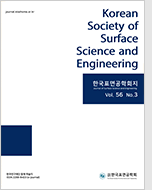
- Past Issues
- e-Submission
-

2021 Impact Factor 1.766
5-Year Impact Factor 1.674
Editorial Office
- +82-2-563-0935
- +82-2-558-2230
- submission@kssse.or.kr
- https://www.kssse.or.kr/

2021 Impact Factor 1.766
5-Year Impact Factor 1.674
The Korean Society of Surface Science and Engineering 2023;56(2):125-136. Published online: May, 2, 2023
DOI : /10.5695/JSSE.2023.56.2.125
Recently, ammonia has emerged as an alternative energy source that can reduce carbon emissions in various industries. Ammonia is used as a fuel in internal combustion engines because it contains no carbon in its components and does not emit any carbon when burned. It is also used in various fields such as fertilizer production, refrigeration, cleaning and disinfection, and drug manufacturing due to its unique characteristics, such as high volatility and easy solubility in water. However, it is highly corrosive to metals and is a toxic gas that can pose a risk to human health, so caution must be exercised when using it. In particular, stress corrosion cracking may occur in containers or manufacturing facilities made of carbon-manganese steel or nickel steel, so special care is needed. As ammonia has emerged as an alternative fuel for reducing carbon emissions, there is a need for a rapid response. Therefore, based on a deep understanding of the causes and mechanisms of ammonia corrosion, it is important to develop new corrosion inhibitors, improve corrosion monitoring and prediction systems, and study corrosion prevention design.
Keywords Ammonia; Corrosion; Toxic; Carbon free; Stress corrosion cracking.